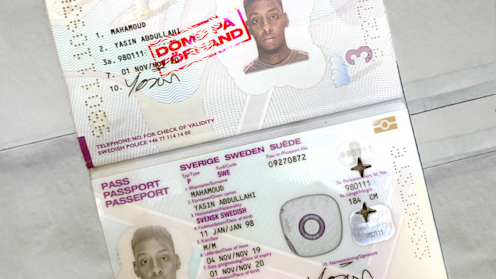
“Sweden’s most wanted”, raps the controversial artist Yasin in his track 20 Talet. The rapper’s lyrics are without filter, direct, raw, born within a marginalised and often criminal environment, depicting a side of Sweden that might be unrecognisable to many. When people think of Sweden they are likely to think of social equality and prosperity, not poverty and crime. They are likely to think of the upbeat danceable grooves of ABBA not the hard-edged beats of Yasin.
However, there has been a growing scene of gangsta rap led by the likes of Yasin. Coming from multi-ethnic Stockholm suburb Rinkeby, the Swedish-Somali rapper is representative of a wave of Swedish rap that exposes the harsh reality of being a minority-ethnic Swede or immigrant growing up in the marginalised suburbs of the seemingly so egalitarian Scandinavian country.
Along with gangsta rappers such as Jaffar Byn, 1.Cuz, 23, and Dree Low, Yasin paints a tough picture flecked with criminality and gang violence. Their music often talks about the difficulties of surviving in Swedish society financially and socially, but more recently also the mental and emotional toll that doing so takes. These songs expose a reality that many do not want to think about, especially in Sweden, a nation that prides itself on the provision of a high quality of life and which pays attention to human rights and individual freedom. As such, certain factions of Swedish society are using these songs to bolster anti-immigrant sentiments and to draw lines around who is Swedish and so who can belong.
Sweden today
Over the past 30 years, Swedish hip-hop has emerged and taken over the nation’s charts. It has given artists, who often come from multi-ethnic and segregated areas, the means to express their opinions about society and reflect on what is happening around them.
Sweden has developed into a multicultural society – but the notion of what Swedishness is has remained mired in the past. Even though minorities groups are increasing in size and are only expected to get bigger, Swedishness (and belonging to it) still has a strong link with being white.
In Swedish hip-hop’s early days in the 1990s, The Latin Kings described the structural inequalities, violence and segregation in such disadvantaged neighbourhoods in a similar way to today’s rappers. But they did so from an observational perspective and with a touch of hope for the future. Today’s rappers, on the other hand, are more embedded in the violence of their surroundings and tend to have a more nihilistic opinion of their future.
Take the track Adressen by 23. He wants his mum to know it’s not her fault that he has been affected by the criminal environment and is stigmatised for the neighbourhood he comes from:
It’s about numbers, digits
I know some Ricos, know some money Mitches
Ah, but it’s no movie, ey, it’s real life
Born to lose, now I realise
That for my zip code, that bloodshed and bullet holes
Never been a runner so I have to be a boss there
Yeah, they like pointing fingers [Translated from Swedish]
The recent wave of gangsta rap has been the result of worsening dynamics in society. Many neighbourhoods such as Rinkeby, which are predominantly multi-ethnic, have been categorised as socially and economically “vulnerable”, suffering with structural inequalities, lack of investment and above-average unemployment, which has lead to high poverty and crime numbers.
These poverty and crime statistics are regularly echoed in media and political discourses, which has led to further stigmatisation of these neighbourhoods and the minority ethnic people who live there. Gangsta rap’s violent lyrics about these neighbourhoods are also used to bolster nationalistic and anti-immigrant rhetoric. Together they are used to create a narrative that promotes the idea that these places are unlike much of Sweden and the people who live there, including these rappers, are not like Swedes.
Between belonging and non-belonging
Not all hip-hop is wrong in the eyes of most Swedes. But the contemporary gangsta rap style has put people on some edge because they associate it with shootings and gang criminality. An increase in violent and criminal incidents in Sweden in recent years is associated by some with the image portrayed by Sweden’s gangsta rappers and their environment.
Yasin, with his Somali roots, connections to local gang Shottaz and criminal convictions, is easily judged beforehand by the public, who can’t separate his current art from his past activities. Yasin expressed this on the cover of his latest album, Del Två (Part Two), which shows Yasin’s Swedish passport stamped with “Dömd på förhand”, meaning “convicted in advance”. Yasin knows that he is not recognised as Swedish, which makes finding belonging very difficult and maybe even not worthwhile.
Hip-hop artist Timbuktu is an outspoken advocate for minorities to be accepted as Swedish, legally and symbolically. In 2013 he got invited to the parliament, where he spoke and he held his passport up in the air, showing that he is Swedish. More recently on the talk show Efter Fem (After Five), he argued that people like him with an immigrant background should not need to ask for permission to be part of the Swedish story – they are and have been for a while.
The current trend for gangsta rap exposes a rather destructive side of Sweden. Yes, it exposes criminality and poverty but it also exposes a society that is resistant to change, or simply not changing fast enough. It highlights just how important it is that cultural conversation move along and how desperately the idea that Swedishness is synonymous with whiteness needs to change. No matter what ethnicity, cultural background, or neighbourhood you live in, anyone should be able to belong in Sweden.
Sjors Joosten receives funding from Stockholm University. He is employed by the university as PhD-candidate.
This article was originally published on The Conversation. Read the original article.







